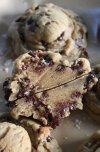Very interesting that you recommended this! I just made a new batch yesterday based on the other users recommendations and it worked & didn’t spread! The only thing I’m trying to figure out now is that the outer part of the cookie was crispy. I think the “corn starch” that I made included might be the cause of this?? I wish I just knew or had a recipe to have a thick cookie that’s soft on the outside as well.
For a softer cookie, use a bleached, low-protein flour. This type of flour bakes lighter in color and creates a more tender crumb.
Flours like Gold Medal or Pillsbury, which are bleached and have around 10.5% protein, are preferred by some bakers for shortbread, sugar cookies, thumbprint cookies, spritz cookies, jam cookies, some cakes since they don’t brown as deeply and produce a more tender texture.
White Lily, with about 9% protein, is another bleached, low-protein flour similar to pastry flour. Its lower protein content results in a lighter color and an exceptionally soft crumb, making it the preferred choice for biscuits, white cakes, sponge cakes, and some cookies, including shortbread.
When bleached flour was banned in the EU and other countries, bakers faced significant challenges in producing their most prized cakes. Bleached flour, particularly cake flour, is prized for producing high-rising cakes with a tender crumb and light color. Without access to bleached cake flour, bakers struggled with cakes that were denser, had a significantly lower rise, a tougher texture, and a darker color.
When comparing different flour brands, you will notice some include malted barley. Malted barley contains enzymes that convert wheat starch into simple sugars. In yeast doughs, these sugars feed the yeast and aid in browning. In non-yeasted doughs and batters, they contribute to browning as well. For example, a high-protein (around 11.5%), unbleached, and malted flour like King Arthur Flour will yield a deep brown crust, denser crumb, and a lower rise. This type of flour is well-suited for drop cookies (such as chocolate chip or oatmeal), rolls, certain breads, and some cakes (like carrot or hummingbird cakes) and most quick breads.
When a very light crumb and color are needed, such as for a chiffon cake, cake flour is essential. Cake flour is always bleached, never malted, and very low in protein, around 8%.
In general, the rule of thumb is to use bleached, low-protein flour for tender, lighter-colored baked goods, and unbleached, high-protein flour for richer, darker-colored, and chewier baked goods.
Regarding leavening agents, baking soda does not create significant spread. Even if you added a full tablespoon of leavening, the spread would not be significantly more than a cookie with no leavening.
 …… I was wondering if anyone had any recommendations on how to keep a CC cookie thick & soft (slightly undercooked). OR if you have a recipe that would be great! I’ve a attached a photo for reference of what my ideal chocolate chip cookie would look like (texture & shape). Thanks!
…… I was wondering if anyone had any recommendations on how to keep a CC cookie thick & soft (slightly undercooked). OR if you have a recipe that would be great! I’ve a attached a photo for reference of what my ideal chocolate chip cookie would look like (texture & shape). Thanks!

